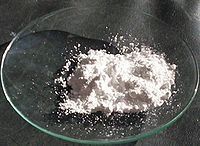
Titanium dioxide, the active
ingredient of OxiTitan VLR
EcoActive Surfaces, Inc. has developed an antimicrobial coating that kills germs using only indoor light, according to a statement issued by the Florida-based company.
According to the manufacturer, the transparent water-based spray, called OxiTitan Visible Light Response, electrostatically traps germs, then finishes them off with oxidizing agents released when the material is exposed to indoor light.
Previously, anti-microbial coatings only worked under a narrow spectrum of ultraviolet light, but EcoActive's technicians engineered the material so it is reactive under the visible wavelength produced by ordinary fluorescent, incandescent and halogen bulbs, according to a statement from the company.



Ad Statistics
Times Displayed: 45539
Times Visited: 1299 Ampronix, a Top Master Distributor for Sony Medical, provides Sales, Service & Exchanges for Sony Surgical Displays, Printers, & More. Rely on Us for Expert Support Tailored to Your Needs. Email info@ampronix.com or Call 949-273-8000 for Premier Pricing.
"It's indoors where bacteria flourish," Stewart Averett, president of EcoActive, tells DOTmed News. UV rays, shed by the sun, are known disinfectants. "You don't have to worry about the door handle on your car [being contaminated by germs] sitting in sun," says Averett. "In 15 minutes, it gets enough sunlight to kill all virus and bacteria on surfaces."
But you do have to worry about bacteria thriving inside homes or hospitals and away from harsh UV rays -- which is where OxiTitan VLR comes in, says Averett.
OxiTitan VLR is made of titanium dioxide and zinc suspended in water. Titanium dioxide, the active ingredient in sunscreens, as well as OxiTitan VLR, is reactive to light. Once a light particle strikes a molecule of titanium dioxide, it excites electrons within it, causing them to jump up and down. When these bouncing electrons smack into water vapor found naturally in the air, they split open water molecules, releasing hydroxyl radicals -- the germ-killing agents that act as oxidizers, according to Averett.
"Any [disinfectant] cleaner, like bleach, ammonia or alcohol," says Averett, "is an oxidizer." Oxidizers kill bacteria by penetrating their cell membranes, triggering chain molecular reactions inside the organisms, causing them to die, says Averett. He notes that OxiTitan VLR is harmless to pets and people, because "our cells are longer and more complex."
Averett expects OxiTitan VLR to be helpful in reducing Hospital Acquired Infections, also known as nosocomial infections. According to Averett, every year over 100,000 Americans die from HAIs, and almost 1.4 million Americans contract an illness during their hospital stay, costing the health care industry between $40 and $50 billion annually.
"They had a human reason [to reduce HAIs], now they have a huge monetary reason," Mr. Averett says. "We believe we can break that nosocomial loop."
Some doctors are not so sure. Dr. Trevor Van Schooneveld, MD, an expert in infection control affiliated with the University of Nebraska Medical Center and the Society for Healthcare Epidemiology of America, acknowledges that the OxiTitan VLR coating is a "significant advance" on previous technology and shows "promising test tube data." But he cautions that "real-world applications of technology such as this" could be different from results in the lab, and believes more research is needed.
Mr. Averett says the product continues to undergo tests at independent laboratories to determine its effectiveness against bacteria.
One liter of OxiTitan VLR costs $87, which works out to "about 25 cents per square foot treated," according to Averett. He says one coating should last three or five years for seldom-used surfaces, and six months for ones that come in frequent contact with shoes, hands or cleaners that can scruff off the coating.
For more information, visit: http://www.oxititan.com/
Source: EcoActive Surfaces, Inc.

